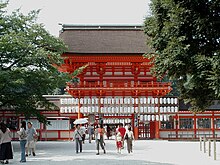| Shimogamo Shrine 下鴨神社 | |
|---|---|
 Shimogamo Shrine | |
| Religion | |
| Affiliation | Shinto |
| Deity | Tamakushi-hime (玉依姫命) Kamotaketsunumi no Mikoto (賀茂建角身命) |
| Festival | Aoi Matsuri (Kamo no Matsuri; May 15th) |
| Type | Shikinaisya Yamashiro no Kuni ichinomiya Twenty-Two Shrines Former kanpeitaisha Chokusaisha Beppyo jinja |
| Location | |
| Location | 59 Shimogamo Izumigawa-chō, Sakyō-ku, Kyoto, Kyoto Prefecture |
| Geographic coordinates | 35°02′20″N 135°46′21″E / 35.03889°N 135.77250°E |
| Architecture | |
| Style | Nagare-zukuri |
| Date established | 6th century |
| Website | |
| www | |
Shimogamo Shrine (Japanese: 下鴨神社, Hepburn: Shimogamo-jinja) is an important Shinto sanctuary in the Shimogamo district of Kyoto city's Sakyō ward. Its formal name is Kamo-mioya Shrine (賀茂御祖神社, Kamo-mioya-jinja).[1] It is one of the oldest Shinto shrines in Japan and is one of the seventeen Historic Monuments of Ancient Kyoto which have been designated by UNESCO as a World Heritage Site. The term Kamo-jinja in Japanese is a general reference to Shimogamo Shrine and Kamigamo Shrine, the traditionally linked Kamo shrines of Kyoto;[2] Shimogamo is the older of the pair, being believed to be 100 years older than Kamigamo, and dating to the 6th century, centuries before Kyoto became the capital of Japan (794, see Heian-kyō). The Kamo-jinja serve the function of protecting Kyoto from malign influences.[3]
The jinja name identifies the Kamo family of kami or deities who are venerated. The name also refers to the ambit of shrine's nearby woods, which are vestiges of the primeval forest of Tadasu no Mori. In addition, the shrine name references the area's early inhabitants, the Kamo clan, many of whom continue to live near the shrine their ancestors traditionally served.[4]
Shimogamo Shrine is dedicated to the veneration of Tamayori-hime (玉依姫, lit. 'the spirit-inviting maiden') and her father, Kamo Taketsunomi (賀茂建角身). Tamayori-hime is the mother of Kamo Wakeikazuchi (賀茂別雷, the thunder-divider of Kamo), who was sired by Honoikazuchi-no-mikoto (火雷神, the God of Fire and Thunder).[5][6] Kamigamo Shrine, the other of the two Kamo shrines of Kyoto, is dedicated to Kamo Wakeikazuchi. These kami are variously associated with thunder.
- ^ Richard, Ponsonby-Fane. (1964) Visiting Famous Shrines in Japan, pp. 1-118.
- ^ Terry, Philip. (1914). Terry's Japanese empire, p. 479.
- ^ Miyazaki, Makoto. "Lens on Japan: Defending Heiankyo from Demons," Archived 2011-03-21 at the Wayback Machine Daily Yomiuri. December 20, 2005.
- ^ Nelson, John K. (2000). Enduring Identities: The Guise of Shinto in Contemporary Japan, pp. 92-99.
- ^ Kōjien Japanese dictionary, entry for Tamayori-bime.
- ^ Kokugakuin University's digital Encyclopedia of Shinto, entry for Tamayorihime.
